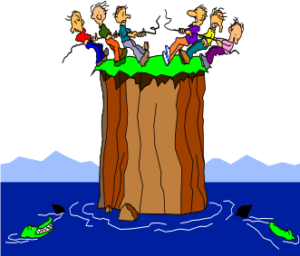
Have you ever been on a team with of wildly talented individuals, some of whom have difficult personalities? I’ve certainly worked on and with groups with an individual whose sole purpose seems to be to wind the team up and cause frustration. And, while I have found that sometimes the root cause is something foundational (like the project delivery method or an ongoing argument about money), one caustic personality in a key role (e.g., Project Manager, Superintendent, Resident Engineer or Construction Manager) can sink a team.
So, how do you navigate the challenging jerk or the highly critical team member who causes heartburn within the team? In this article we will share 8 sets of strategies for you to apply. I hope you find them helpful!
1. Understand the Root Cause of Conflict
Before making any changes, invest time to understand what might be causing the friction. Recognize that any “conflict” requires at least two sides contributing. As my Dad likes to say, “It takes two to tango.” An individual’s perceived “difficult” behavior could stem from:
- Stress or pressure due to tight deadlines or personal issues.
- Miscommunication resulting from unclear instructions or differing interpretations.
- Personality differences like varying approaches to work, levels of experience, or styles of communication.
By seeking to understand each team members’ behavior, you will gain insights that could help reduce or manage the conflict. Further, by taking this approach you are encouraging empathy and demonstrating that it is possible to speak to both parties in a rational way.

2. Practice Effective Communication
Clear and concise communication is essential to avoid misunderstandings. With a difficult team member, the “rules of engagement” become even more critical. Here’s how to improve communication:
- Stay calm and composed even if the other person is unable to. Allowing your temper to flare means you will lose your ability to manage the conflict. Staying calm on the other hand enables you to think and speak more effectively.
- Be direct but polite when addressing issues. If they’re late with deliverables or not following safety protocols, “be specific!” Concrete examples will help you drive your point home.
- Listen actively by letting them explain their perspective without interruption. This shows respect and can sometimes reveal the underlying causes of their behavior.
3. Set Boundaries and Expectations
Establishing clear boundaries and mutual expectations can help prevent conflicts before they arise. To do this effectively:
- Define roles and responsibilities at the beginning of the project to reduce misunderstandings about who is accountable for what. Don’t be afraid to draw a picture or develop “swim lanes” using a RACI Chart/Responsibility Matrix.
- Set communication protocols for site meetings, emails, and updates so everyone understands how to share information. Investing time up front to agree on naming conventions for meetings emails and agreements that all meetings must include an agenda with an objective can help avoid wasted time and effort.
- Address boundary-crossing behavior promptly but diplomatically. For example, if a team member consistently dismisses your input, ask for feedback on how to better integrate your ideas rather than letting resentment build.
4. Find Common Ground
Focusing on shared goals rather than personal differences can ease tension. Here are a few ways to build camaraderie and mutual respect:
- Remind them of the project’s goals and the role they play in achieving them. Partnering gives us a vehicle to set up this conversation. Focusing on the team’s global goals helps everyone reframe conversations around shared objectives.
- Acknowledge their expertise or contributions whenever possible. Difficult behavior is often softened when people feel appreciated and acknowledged.
- Collaborate on problem-solving for challenges that arise. Involving them in solutions demonstrates trust and can create a sense of teamwork and reduce friction.

5. Maintain Professionalism
While you don’t need to be best friends, maintaining a professional approach can make the working relationship smoother. Here’s how to ensure professionalism prevails:
- Avoid gossiping or venting about them to other team members. From my experience the negative talk always seems to have a way of circling back to the original target and tends to damage relationships.
- Use “I messages” when you are addressing behaviors. By sharing (“I feel like X when this happens…”) shows how their language or behaviors impact you without immediately blaming them makes the change conversation last longer than 30 seconds.
- Focus on behaviors, not personality traits when giving feedback. For instance, say, “When deadlines aren’t met, it impacts the team’s momentum,” rather than “You’re just so flaky.”
6. Choose Your Battles
In the fast-paced construction environment, technical disagreements are appropriate and valuable, whereas personality disputes tend to bog teams down. Try to focus on problems that truly impact the project:
- Ask yourself if a behavior directly affects project outcomes before addressing it.
- Look for compromises on smaller issues to avoid unnecessary confrontation. For instance, if they insist on a different approach that isn’t ideal but won’t harm the project, it might be best to go along.
- Stay flexible to manage the ebb and flow of personalities without causing disruptions in the team’s morale.

7. Involve a Third Party if Needed
When conflicts persist and significantly impact the project, it may be necessary to pull in your Partnering Facilitator or a Senior PM/HR Rep. Ideally, you will have attempted to handle the issue informally first:
- Request a facilitated meeting to openly discuss the issue and explore solutions.
- Encourage the third party to set up a framework for future interactions. It is common to develop a mediated agreement to ensure each party has clear guidelines for collaboration or workplace interactions.
- Stay open to constructive criticism during the process. It is common for one or both parties to underestimate how they are contributing to the conflict unknowingly.
8. Focus on Your Own Growth
Difficult people often challenge us to reflect and improve our own emotional intelligence, patience, and resilience. While these situations are challenging, they also offer valuable growth opportunities. Here’s how to foster self-improvement:
- Recognize triggers that cause you to react emotionally and practice self-regulation to avoid lashing out.
- Seek feedback from trusted colleagues or your Partnering Facilitator on how you handle challenging relationships, as they may offer perspectives you hadn’t considered.
- Reflect on successes and missteps after each project phase to better handle similar situations in the future.
Effectively working with a difficult project team member requires patience, empathy, and strong communication skills. On some projects, these difficult personality types will get removed because they are not a “fit.” On others, they are allowed to stay because they are key contributors, offer an essential perspective, or are in a role of authority, so the team cannot do anything about it.
While it’s not always easy, it’s important to remember that maintaining professionalism and reminding your difficult team member of your shared goals will help you improve collaboration, reduce stress, and keep the project on track. If you are struggling, I hope you will test a few of these strategies and let us know how they are working for you!
– Rob
Rob Reaugh is President of OrgMetrics LLC. He facilitates the City and County of San Francisco Collaborative Partnering Steering Committee and currently works with San Francisco International Airport, San Jose International Airport, BART, Caltrans, and others. He holds a Masters’ Degree in Alternative Dispute Resolution.
For more information please contact Rob Reaugh, RobReaugh@Orgmet.com / (925) 487-2404 (cell), or OrgMetrics, (925) 449-8300.


 Rob Reaugh is President of OrgMetrics LLC. He facilitates the City and County of San Francisco Collaborative Partnering Steering Committee and currently works with San Francisco International Airport, San Jose International Airport, BART, Caltrans, and others. He holds a Masters’ Degree in Alternative Dispute Resolution.
Rob Reaugh is President of OrgMetrics LLC. He facilitates the City and County of San Francisco Collaborative Partnering Steering Committee and currently works with San Francisco International Airport, San Jose International Airport, BART, Caltrans, and others. He holds a Masters’ Degree in Alternative Dispute Resolution.